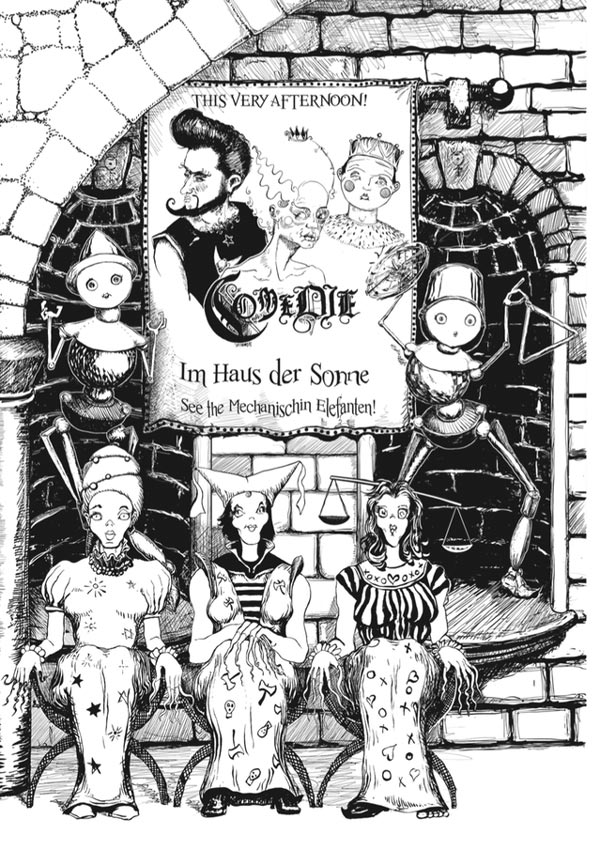In 1616, a very odd little book was published in what is today Germany. Its narrator, Christian Rosencreutz, told the tale of his bizarre and otherworldly foray into a secret society. It featured angels, automata, and ancient, arcane wisdom. Some readers viewed it as a religious allegory, some as an alchemical one. Some—in light of two manifestos published in the years preceding it—thought this book a revelation of a true secret society: the Rosicrucian order, a group of hermetic, Christian alchemists that were poised to change the world. Not, perhaps, features we’d associate with modern science fiction.
Author John Crowley, however, is reclaiming The Chemical Wedding. Alchemy, he argues in his introduction to Small Beer Press’ new edition, “had the same fascination for readers of the [Renaissance] as the scientific possibilities of classic SF did in its last-century heyday.” No matter its associations today—with the occult, Nicholas Flamel, or Fullmetal Alchemist—alchemy was once a cutting-edge science, one that well-respected men like Isaac Newton and Giordano Bruno thought would heal society’s political and religious rifts. Crowley’s new edition of the alchemical Wedding attempts to resituate it in these terms. Published during the year of the book’s 400th anniversary, with Gorey-like illustrations by Theo Fadel, The Chemical Wedding is living and breathing yet again, reopening a bizarre and understudied chapter in European history.
The plot of The Chemical Wedding is less interesting than its history or its detail. In it, Christian Rosencreutz is invited by a king and queen to a mysterious castle full of magic and wonders, to witness a royal wedding. He and the other invitees undergo a series of trials to prove their purity and righteousness, from being literally weighed by their embodiment of each of the seven deadly sins, to their alchemical prowess and curiosity. The book is divided into seven days (always a telling number), though as Crowley points out, there is in fact an eighth, incomplete day at the end of the book. Perhaps the most fascinating scenes in the book involve Christian sneaking away on his own, exploring the castle’s many libraries and oddities (only later does he find out that what he’s done is forbidden, and that he’ll be punished). The ending, though abrupt, is a happy one. Christian returns home and, presumably, spreads the good news of the Rosicrucian brotherhood by writing The Chemical Wedding (the actual author of the book, it was later revealed, was Lutheran pastor and mystic Johann Valentin Andreae).
Originally released on the eve of the Thirty Years’ War, The Chemical Wedding is garishly optimistic in hindsight. It promises religious and political harmony, and a rebirth in scientific progress that will rattle society to its very core. Dame Frances Yates, in her groundbreaking history The Rosicrucian Enlightenment, even argues that the royal wedding that Christian witnesses is a symbolic retelling of that of Frederick V, Elector Palatine of Bohemia, and Princess Elizabeth Stuart of England. This marriage, when it took place in 1612, was looked upon as a meeting of worlds and a reconciliation of difference; a new Europe was on the horizon. Science (alchemy) and the arts flourished, and the couple was loved very briefly by their people, until war erased the optimism that the union and The Chemical Wedding both symbolized.

John Crowley’s ambition in re-configuring Andreae’s forgotten book is laudable, and Fadel’s whimsical, dark illustrations add still more modern elements to the new edition. Re-imagining the text as science fiction is an exercise that makes outdated science feel alive and relevant, where it’s so often presented as stale and superstitious. I quibble, slightly, with the designation of The Chemical Wedding as a novel. Its fictional and romantic nature is all but uncontestable. However, the fact that so many readers took Andreae’s story as true (if not in event, than in allegorical content) says something about its context, its intent, and about the reverence its original audience had towards the written word. Despite its bizarre imagery and symbolism, it bears more resemblance to John Bunyan’s Pilgrim’s Progress than it does to any contemporary novels. Andreae did dismiss his own work later in life, but whether that is due to his youth and inexperience, or the book’s whimsical content is unknown and unknowable.
Whether you consider The Chemical Wedding a religious text, a morality tale, or a work of science fiction, however, the fact that it remains so rich in interpretations is one of its greatest strengths. It’s a read that is simultaneously dry and bizarre, but it’s anything but tiresome. Its original uncanniness is only heightened by Crowley’s new edition, and the specificity of its historical moment made more familiar.
The Chemical Wedding is available from Small Beer Press.
Emily Nordling is a library assistant and perpetual student in Chicago, IL.










